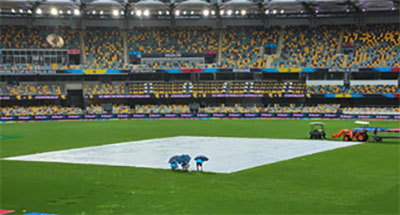Life on the West Island - West Island Enigmas

27 October 2022
This week, Life on the West Island begins what might (or might not) become an ongoing series looking at 21st Century West Island Enigmas, starting with La Niña, World Cup and DLS. This rather convoluted subject brings together extreme weather, elite cricket and complex mathematics.
Right now, the West Island is hosting the World T20 Cricket Cup. Twelve national teams have qualified for the final knockout stage and just a few games have concluded, but already there is one clear favourite to determine the winner of the trophy – not a national team but the phenomenon of La Niña.
What? The official website of the Bureau of Meteorology (aka The Bureau or BoM) sort of explains what La Niña means, albeit in complicated language:
La Niña continues. In the tropical Pacific Ocean both atmospheric and oceanic indicators of the El Niño–Southern Oscillation (ENSO) are consistent with an established La Niña, including tropical Pacific sea surface temperatures, the Southern Oscillation Index (SOI), trade wind strength, and equatorial cloudiness. Models indicate a return to ENSO-neutral conditions (neither La Niña nor El Niño) early in 2023. La Niña typically increases the chance of above average rainfall for northern and eastern Australia during spring and summer. The negative Indian Ocean Dipole (IOD) event also continues. The IOD index has satisfied negative IOD thresholds (i.e. at or below −0.4 °C) since June. Models indicate that the negative IOD is likely to persist into late spring before rapidly decaying. A negative IOD typically increases the chance of above average spring rainfall for most of the eastern two thirds of Australia.
Got it? Well, what it really means in everyday language is that for about nine months, it’s going to be bloody wet over most of the continent. If you don’t believe that, just look at the massive rainfall figures in the past 60 days and the floods currently devastating vast swathes of four states, especially in inland areas.
The continuing rain is playing havoc with the scheduled World Cup cricket games. Of the nine listed games, one was abandoned without a ball bowled, one achieved no result despite trying to play through the showers and another was drastically shortened by rain. With forecasts of many more drenchings to come, it seems likely that the points tables will reflect which teams manage to avoid the downpours and achieve results on the scoreboard. In other words, the World Cup might go to the driest team, rather than the one best at winning cricket games!
The further complication is that when some overs are lost due to rain, run targets and overs to be bowled are calculated using what can only be described as a complex mathematical formula, now known as the Duckworth-Lewis-Stern method (or DLS).
See if you can work out how this is done from the official description of DLS:
The Duckworth–Lewis–Stern method (DLS) is a mathematical formulation designed to calculate the target score (number of runs needed to win) for the team batting second in a limited overs cricket match interrupted by weather or other circumstances. The method was devised by two English statisticians, Frank Duckworth and Tony Lewis and was formerly known as the Duckworth–Lewis method (D/L). It was introduced in 1997, and adopted officially by the ICC in 1999. After the retirements of Duckworth and Lewis, Professor Steven Stern became the custodian of the method and it was renamed to its current title in November 2014.
The target score in cricket matches without interruptions is one more than the number of runs scored by the team that batted first. When overs are lost, setting an adjusted target for the team batting second is not as simple as reducing the run target proportionally to the loss in overs, because a team with ten wickets in hand and 25 overs to bat can play more aggressively than if they had ten wickets and a full 50 overs, for example, and can consequently achieve a higher run rate. The DLS method is an attempt to set a statistically fair target for the second team's innings, which is the same difficulty as the original target. The basic principle is that each team in a limited-overs match has two resources available with which to score runs (overs to play and wickets remaining), and the target is adjusted proportionally to the change in the combination of these two resources.
So which is harder to understand from the official descriptions - La Niña or DLS? Put them together and what have you got – a very large number of confused cricket players and supporters!
Take these two recent results from the same day:
- · Side A was all out for 157 in 19.2 overs and Side B was 5/105 off 14.3 overs when the rain came. Who won? Answer: Side A by 5 runs.
- · Side C was 7/139 after a full 20 overs. When play was stopped due to rain, Side D was 5/120 off 17.2 overs – that is, they needed 20 runs off 16 balls to win when the heavens opened. The winner was side D by 3 runs.
It might be just as fair to draw team names from a hat to decide winners!
So, the first one in this possible continuing series of 21st Century West Island Enigmas remains enigmatic. The World Cup goes on in the midst of soaking rains delivered by La Niña. Who will triumph? Maybe Ireland or New Zealand? Or could it be the weather…